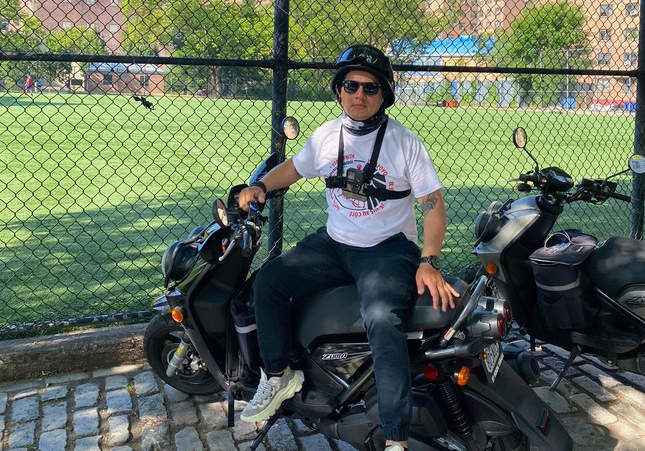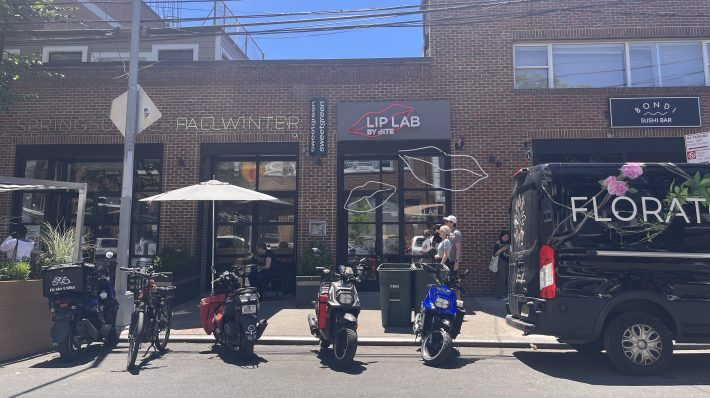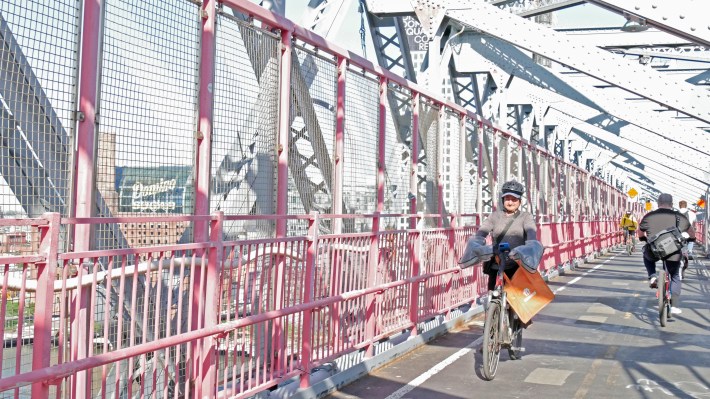This delivery is a mixed bag.
The city's minimum pay law for delivery workers has dramatically improved wages for tens of thousands of workers, but also reduced some workers' hours as the previously unregulated delivery app industry retooled for greater efficiency, a new report shows.
Data just released in a quarterly city report shows that delivery worker earnings increased from $11.72 per hour to $19.26 per hour after tips — a jump of 64 percent — since last year and total orders have gone up. But tips have gone down from $4.30 per hour to $2.30 per hour due to changes in the way the app companies allow users to add a tip onto their bills.
Nonetheless, full-time delivery workers are, on average, seeing higher paychecks.
The data tells the story of an industry reckoning, with app companies striving for increased efficiency now that the companies must pay workers for “active” time. As a result, companies such as DoorDash and Grubhub have changed how workers interact with the app, limiting scheduling and creating opaque judgment systems that seem to prioritize workers who accept the most deliveries and finish the fastest. This reduces some workers' hours (and therefore their pay), even though the average earnings per hour have increased. Experts say this is the industry regulating itself.
"Online hours have gone down quite a bit, even though the number of orders has gone up and the number of deliveries per hour increased by about one-third. Economists would see that an an improvement in efficiency," said James Parrott, the director of economic and fiscal policies at the Center for New York City Affairs at The New School, who consulted with the city on the landmark minimum pay law, but had no involvement in the new report, which stems from a long-sought data reporting requirement in the minimum pay law.
The app-companies claim the latest data prove their predictions about problems with the minimum wage law. An Uber spokesperson, for example, said the report proves that the law was a "job killer" because there are now 12,000 fewer delivery workers.
But workers blame the apps, not the law.
In interviews with Streetsblog, full-time delivery workers said they are earning more money. But some delivery workers said they can't reach the minimum wage, which is now $19.56 per hour, because of confusing scheduling rules. And all workers said they are earning lower tips.
The decrease in gratuity is due to companies hiking fees to app customers and then moving the tipping option to the end of the transaction, after the user sees how much an order will cost. This practice was predicted in the Department of Consumer and Worker Protections' earlier report, a Minimum Pay Rate for App-Based Delivery Workers. The new data shows that as fees to customers have increased, the average price of an order has stayed basically the same — which is why tips have gone down by about half.
"Upfront [customers] have to pay more to the companies, leaving less generosity on the part of the customers to tip," said Parrott.
Fewer hours, faster deliveries
Because the data isn’t broken down for each worker — it only shows general trends — it doesn’t tell the full story. Even though workers are making more on average per-hour, the changes in access to scheduling have made things hard for many who rely on these apps as their only source of income.
Advocacy groups like Los Deliveristas Unidos, which led the fight for the pay standard, are working to keep deliveristas educated about the benefits of the minimum wage. The group sees the changing tipping structures and app "lockouts" as retaliation from the apps, not as a product of the minimum pay law.
"They are trying to divide the people but one of my jobs is to make sure deliveristas don’t get confused," said William Medina, a worker and organizer with Los Deliveristas Unidos.
The increased efficiency, as the data shows, has led to less total active time on the apps, but it has also made delivery speeds faster. On the streets, some delivery workers feel they have to rush to get orders in on time because they don't want to be deprioritized by the apps' algorithms if they drop off an order late.
Delivery workers completed an average of 1.89 deliveries per hour in the first quarter of 2024, up 25 percent from 1.51 deliveries per hour in the first quarter of 2023, according to the data.

Medina says workers are upgrading their bikes so they can meet the demand and get orders done on time. When Medina started working he used a regular bicycle, he then upgraded to a battery-powered e-bike and now uses a gas-powered moped that he has legally registered.
That comes with a downside: In January 2023, there were only three reported injuries caused by moped or motorcycle riders. But in January 2024, that number rose to 16, signaling an increase in the use of mopeds.
“This is a public safety issue. Deliveristas have to run around the city like crazy, they're doing this because they need to keep their accounts open,” said Medina.
Division among workers
The data shows improvements for workers on average, but based on conversations with workers it is clear that not all are benefitting in the same way, or at all. Those working full-time who have a track record of fast deliveries and accepting orders are seeing an increase in pay and they are the ones who are able to schedule hours.
On North Fourth Street in Williamsburg, where large groups of workers wait each day to pick up lunch orders from fast-casual restaurants like Sweetgreen and Cava, two full-time delivery worker from Bangladesh described making more money since minimum wage was introduced.

"It's better now, I can make more money," said Shahmim Hossain, who works for GrubHub and has been doing delivery work for five years.
Both workers complained of a decline in tips.
"It's hard work, we have to go out in bad weather and dangerous conditions. When we had large orders we used to be able to expect big tips, now it's less," added Md Rahat, a delivery worker of five years who was currently working for DoorDash.
Rahat and Hossain told Streetsblog that although they've seen a bit of a reduction in hours they feel less rushed now that they are being paid by time, rather than by order, and are on the whole making more money.
Other workers who used the apps to supplement income are struggling to find the same flexibility and new workers are on waitlists trying to get a chance at what has been seen as an open work opportunity.
"All of the apps have a waitlist because there is a lot of demand [for full-time work]," Anthony Gonzalez, a part-time worker told Streetsblog in Spanish. He added that he's been trying to get full-time work for a year.
Gustavo Ajche, one of the founding worker-organizers with Los Deliveristas Unidos, works as a roofer during the day, but would often sign onto the apps after work. Now, he says he can't use them in the same way.
"Two to three years ago, the applications did have the flexibility that they promised," he said. "It used to be good for me because I could just open the app and use any app I can, but you can't do that anymore."
Now that the companies are forced to pay workers for all the hours on which they are active on the app for deliveries, the companies limit access to the system, which alienates a lot of workers. But Parrott saw that as an inevitable change.
"It should've been the case that the companies were moderating the amount of workers they let onto the platform to keep the growth in their workforce aligned with the growth in orders. Now it looks like the workers are being denied access, but thats all a function of the Wild West business model that the companies had before minimum pay," he said.
Ajche still thinks the minimum pay is an improvement for workers because they aren't solely reliant on tips to make a living wage.
"Before minimum pay, the worker depended almost ninety percent on tips. Minimum pay, the idea, is that the worker doesn't have to rush, they have a wage," said Ajche.

The scheduling algorithms used by the app companies to determine who gets orders when, how far apart the orders are, and how much time they have to make the delivery has an increased effect on workers lives when they are doing gig-work full-time.
“Your dependence is a proxy for your vulnerability to the algorithms. If you are dependent on the app as a full time worker you are more susceptible to the tactics they use to maximize profit,” said Zoey Laskaris, a Research Assistant Professor at Queens College and the lead author of the report.
The need for better data
The aggregate data provided by the city is a good start in analyzing how the pay standard affects deliveristas, but more detail is needed to fully understand the effect this law has had on individual workers.
But the data we do have shows a clear wage increase for worker's active time, as well as industry growth — the number of deliveries increased by 8 percent.
"These strong results show yet again that we don’t have to make the false choice between business growth and workers’ rights; with enough vision, just wages can and ought to be the foundation for business models that thrive," Ligia Guallpa, executive director of Worker's Justice Project, said in a statement.






